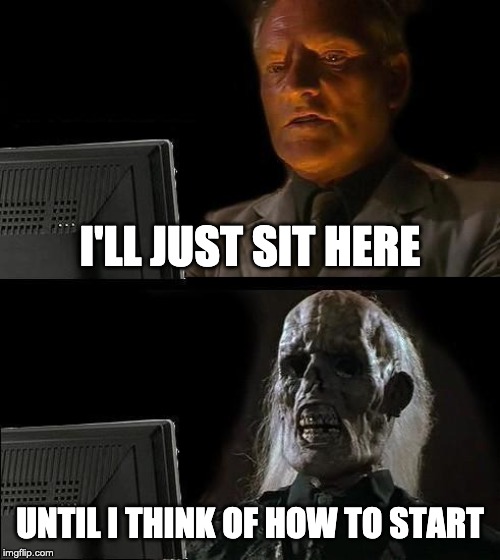(Or, how to get started writing quickly.)

How many times has this happened? You make some time to sit down and write. Great, pat yourself on the back! Then you sit there, computer on, file open, cursor blinking, but no words appearing on the screen. You can’t think of what to write. Nothing is coming and time is passing. You begin to get frustrated, annoyed. Eventually panic sets in. Negative emotions take over and your writing session has been derailed. Maybe you eventually have a breakthrough and get going, but you lost a lot of valuable time in the interim. Or maybe you give up and watch cat videos instead.
I’ve been there myself. In the academic world, many times deadlines are flexible or non-existent. If you don’t finish your thesis this semester, you can push graduation back to next semester. You can submit the manuscript next month. Now, even many grant programs have windows for submission rather than hard deadlines. These flexible deadlines can take some pressure off, but on the other hand, they remove the sense of urgency that can spur action. Now that I’m a full-time writer in the real world, I think it’s a shame how much time is wasted in academia. Students and postdocs, it is often up to you to establish your own deadlines and drive your projects forward with urgency. Writing with efficiency is key to moving forward and making steady progress. Today, I’m going to give you three tips on how to quick-start your writing sessions.
1. Begin with freewriting.
Freewriting is just what it sounds like, writing freely. In other words, just start typing whatever comes into your head. It can be nonsense, it can be about your lunch plans, it can be observations about your surroundings. It really doesn’t matter what you write to get started, because you can go back and delete it later. Soon, within 5-10 minutes, your brain will switch over to what it is supposed to be writing about, and you will launch into it with momentum.
2. Interview yourself.
Somewhat different from freewriting, you will start by writing a question to yourself, followed by an answer to your question. That will naturally lead to another question, and another answer. After a few of these back-and-forths, your brain will be ready to write what is is you are supposed to be writing.
For example, you could have a conversation with yourself like this:
What are you writing today? I’m supposed to write the Introduction of my paper.
What is your paper about? It’s about molecular control points of the widget life cycle.
How do these control points work? Well, Protein A phosphorylates Protein B, which then starts a signalling cascade to …. Got it, ready to write.
While you are here, why not take a look at some other posts? Here is one on writing style.
3. Set up your beginning in the previous session.
Using this tip takes some planning in advance. You could prep for it at the end of your previous writing session (take a look at this post), or in your pre-writing planning. Basically, at the end of your writing session, stop at a point where you know what it is your need to write next. Then when you come back, it will be easy to get going. Alternatively, you could leave yourself a to-do list when you are wrapping up the session, so that when you come back, you have instructions on where to begin.
Do you have other tips that you use to begin writing quickly? Leave a comment below!

0 Comments